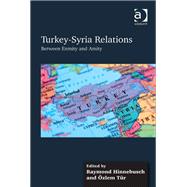Turkey-Syria Relations: Between Enmity and Amity
, by Hinnebusch,Raymond- ISBN: 9781409452812 | 1409452816
- Cover: Hardcover
- Copyright: 4/11/2013
In 1997 Turkey and Syria were on the brink of war, engaged in a very real power struggle. Turkey was aligned with Syria's main enemy, Israel, and there were seemingly intractable differences on the issues of borders, the sharing of river waters and trans-border communities. In less than a decade, relations were transformed from enmity to amity. Border issues and water sharing quarrels were moving towards amicable settlement and the two states' policies toward the Kurdish issue converging. Turkey undertook to mediate the Syrian-Israeli conflict and close political and economic relations were developing rapidly between the two states. Yet, with the Syrian Uprising, relations returned to enmity. What explains these remarkable changes? Given that Turkey and Syria are two pivotal states in the region, what are the implications of this changing relationship for the international politics of the Middle East, the balance of power and regional stability? In this internationally collaborative work, co-edited by Raymond Hinnebusch and Ozlem Tur, British, Syrian and Turkish scholars address these questions and examine the various domestic and international drivers in this key regional relationship. They discuss what theories best help us understand these seismic realignments and explore the impact of economic interdependence, identity changes and power balances on the evolving relationship between these two key regional powers.






